Shiso (
Perilla frutescens)
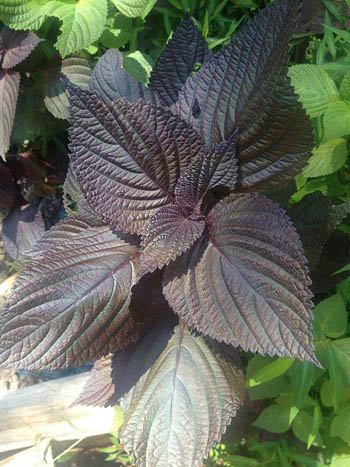
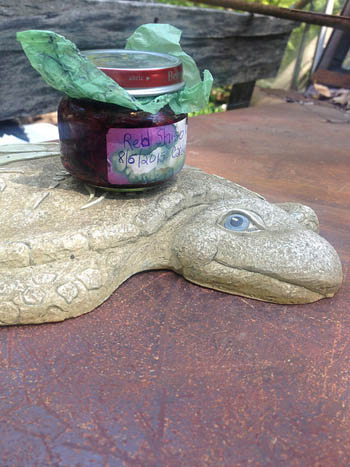
Red-leaved shiso, also known by the awkward name "beefsteak plant," is wonderfully easy to grow and a delight to the eyes and the palate. Like holy basil (tulsi) – its sister – shiso is an adaptogen with high levels of antioxidants.
I love shiso in salads, gazpacho, marinated cucumber dishes, and anywhere else a dash of color and an interesting taste is welcome. Right now I am making shiso vinegar, shiso honey, and shiso pesto so I can enjoy it all winter too.
This pungent, aromatic, warming herb is known for its antibacterial, antiseptic, antispasmodic, antitussive, tonic, carminative, diaphoretic, emollient, expectorant, and pectoral actions. No wonder its considered so useful when dealing with asthma, colds and chills, nausea (a tea of the stalks is traditional in China as a remedy for morning sickness), abdominal pain, food poisoning, allergic reactions (especially from seafood), bronchitis and even constipation. The juice helps heal cuts and wounds.
The high-protein tasty seeds are antiasthmatic, antitussive, emollient and expectorant. But don't eat too many, as shiso self-sows readily if sufficient seeds are left on the stalks. As with all mints, there are lots of varieties of shiso available. I prefer the red-leaved shiso because I am into consuming high levels of the antioxidant anthocyanin, found in purple and blue plant parts.
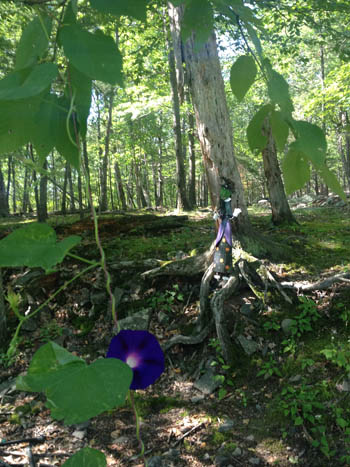 Green greetings from the heart of the harvest.
Green greetings from the heart of the harvest.
We had a most wonderful weekend with the Herbal Medicine Chest and Herbal Ferments here at the Wise Woman Center. The weather was fine and the plants abundant as we gathered, foraged, and processed.
We went for a walk along the river and – since our infusion of the day was red clover – we talked at length about phytoestrogens, and xeno-estrogens, and estradiol, and how to keep our breasts healthy and cancer free. We visited with the friendly roots: burdock, Dr. Dandelion, pokeweed, and echinacea. We discussed the difference between yarrow leaves and yarrow flowers.
Later, while gathering greens for our wild salad, we stopped by a cultivated plant that I love – garden sorrel – and her wild baby sister, sheep sorrel. Their sour taste is just the thing on a hot August day. Read more about the sorrels and their sisters here.
We finished the day with more "plants I don't leave home without." And, responding to students' requests, we made a mullein tincture, and smeared ourselves with plantain oil.
Sunday was just as enjoyable, but far more delicious, what with tasting – and learning how easy it is to make – fermented foods like yogurt, kefir, kombucha, sauerkraut, sourdough, herbal wines, herbal beer, and lacto-fermented everything, including seaweed, herbs, roots, and fruits.
I was planning to make (well, get started) some wild carrot flower wine using the recipe for dandelion flower wine in Healing Wise. And I had planned to lacto-ferment some grape leaves, and make a lacto-fermented tomatillo chutney, but the class had other plans: they wanted more medicine chest herbs.
Off we went into the woods in search of skullcap. (We found it.) Back we came to hang out with the sisters wormwood and cronewort. Then we made slippery elm balls, and extolled their virtues. It's easy. So easy my granddaughter does it, at age six, on camera (by her request).
The presence of the dancing green women was felt. We imbibed her blessings and felt our hearts beat as one with the heartbeat of the Earth. Imagine yourself with us, remembering the wisdom of our Ancestors, the plants. And becoming more aware of the green blessings that are everywhere.
The Knotweed Family
The knotweed, or smartweed, or buckwheat family – the Polygonaceae – is an interesting family that is probably represented by one or more species right outside your door, no matter where you live.
Most knotweeds have terminal (at the upper end) clusters of conspicuous droopy or upright pink or white flowers that are so tightly closed they look like knots. Wild buckwheat and cultivated buckwheat (which is also known as kasha) have flowers like this. Here are a few of the many knotweeds growing within a few steps of my house.
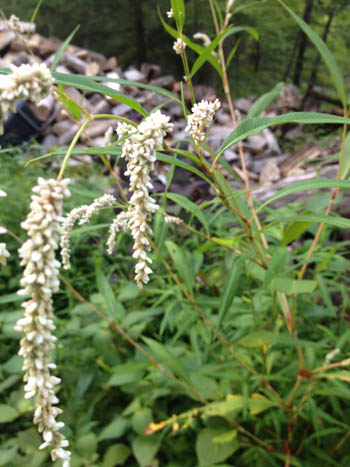
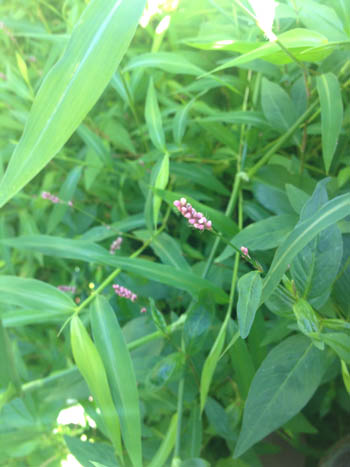
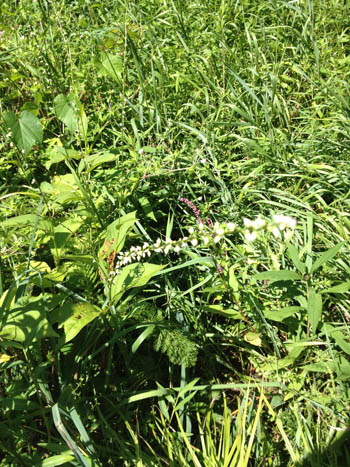
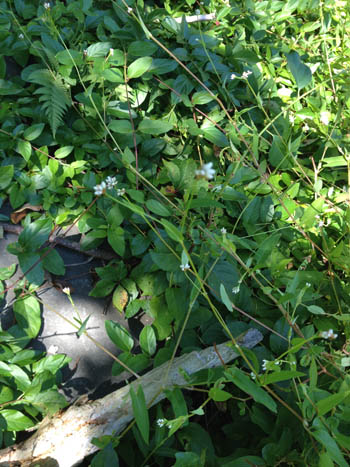
Other plants in the buckwheat family have small, knotty, green flowers on a stiff upright stalk. One of the most important members of this family, rhubarb, blooms like this. While the leaf stalks of rhubarb are edible and delicious, it is the root that has been revered for centuries as a potent herbal medicine. (Too potent for me, thank you. I will stick to my rhubarb/strawberry pie.)
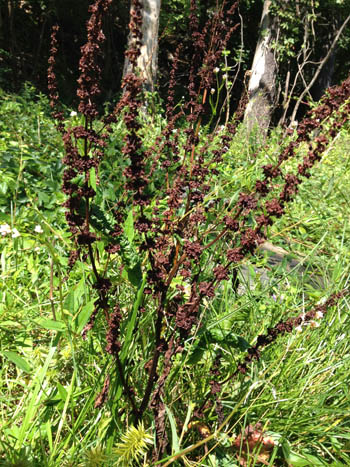
The constituent that makes rhubarb root a big medicine is also found in yellow dock roots, albeit, thank goodness, in smaller amounts. Where rhubarb root can blast the intestines, yellow dock root, taken regularly, keeps you regular. We'll be digging yellow dock root in my roots class, October 4. Right now, we are making yellow dock seed vinegar, as the seeds have many of the same good effects as the roots.
A near relative of yellow dock is garden sorrel, and her wild sister sheep sorrel. Both have "eared" leaves with a wonderful acidic, tangy taste that brings a smile to my face and a cooling breeze to my brow. Perfect in salads, sorrel leaves also star in cooked dishes such as Shav (sorrel/potato soup). The sheep sorrel bloomed long ago and is now putting out new, young, reasonably-large (for a small plant) leaves. Delicious. Vitamin-C rich. Antioxidant rich. Folic acid rich. Fun plants. Find. Eat. Enjoy.
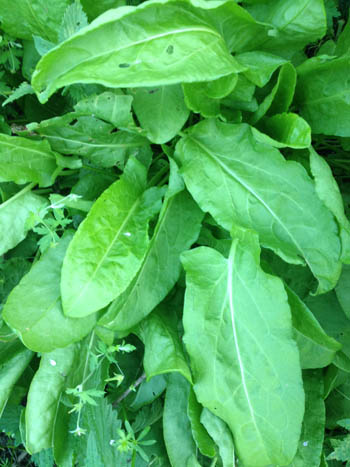
Garden Sorrel
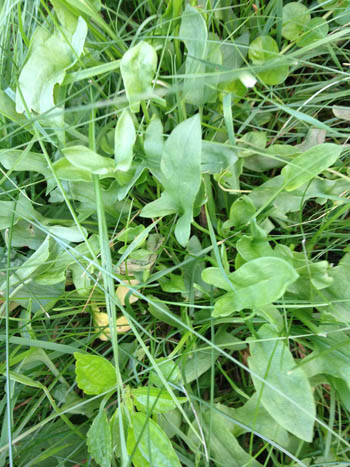
Sheep Sorrel
Get to know a knotweed this week. Eat a bowl of kasha. Green blessings are everywhere.

 Author: Susun S. Weed.
Author: Susun S. Weed. 

 Green greetings from the heart of the harvest.
Green greetings from the heart of the harvest.







